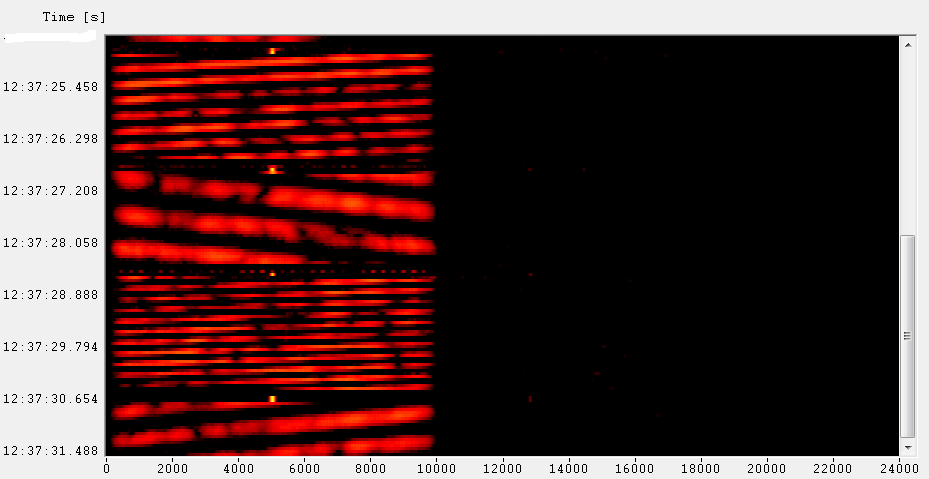Australia’s Jindalee Operational Radar Network (JORN) is operated by the Australian Defence Force (ADF) and comprises three Over The Horizon Backscattered Radar systems and forms part of a layered surveillance network providing coverage of Australia’s northern approaches.
JORN is an FMCW "burst system" covering 10 Khz bandwidth with different sweeprates, this feature is clearly visible in its spectrum:
I heard a quite long session from JORN on 11 February, at 1240z on 18589.0 KHz. According to my observations on the received session, the system transmits sequences of 5 bursts on 10KHz bandwidth, each burst contains 64 sweeps and a single sequence is 9.5 seconds long.
Each burst switches the radar swee-prate to short range (high sweprates) and to long range (lower sweeprates) and is "announced" by an intro-tone (a "pilot tone" one ?) at the center QRG: I do not know if these tones are for sync purposes of the receiving system.
b1: 28us sweep width
b2: 24us sweep width
b3: 30us sweep width
b4: 27us sweep width
b5: 25us sweep width
(the accuracy of the measurements depends on me and the used tool)
The Australian Defence Force (ADF) currently operates three OTHR systems as part of the Jindalee Operational Radar Network (JORN). These radars are dispersed across Australia — at Longreach in Queensland, Laverton in Western Australia and Alice Springs in the Northern Territory — to provide surveillance coverage of Australia’s northern approaches.
• Radar data from these sensors is conveyed to the JORN Coordination Centre (JCC) within the Air Force’s No 1 Radar Surveillance Unit (1RSU) at RAAF Base Edinburgh in South Australia. 1RSU is tasked by higher headquarters to operate the JORN capability on a daily basis.
• JORN does not operate on a 24 hour basis except during military contingencies. Defence’s peacetime use of JORN focuses on those objects that the system has been designed to detect, thus ensuring efficient use of resources.
• The JORN radars have an operating range of 1000–3000km, as measured from the radar array. Figure 2 depicts the locations of the three OTHR systems and the JCC, and highlights the coverage of each radar. Of note, the Alice Springs and Longreach radars cover an arc of 90 degrees each, whereas the Laverton OTHR coverage area extends through 180 degrees.
JORN is expected to detect air objects equivalent in size to a BAe Hawk-127 aircraft or larger and maritime objects equivalent in size and construction to an Armidale-class patrol boat or larger.
JORN is currently undergoing a capability upgrade under JP2025 Phase 5 (1987 Defence White Paper, Joint Project 2025). This project will incrementally deliver a number of capability enhancements to the current JORN radars located at Longreach and Laverton, and will compliment upgrades delivered under Phases 3 and 4 to bring these radars up to the current technological specification of the OTHR at Alice Springs. Phase 5 will also integrate the Alice Spring OTHR into the Jindalee Operational Radar Network.
• The capability upgrade under JP2025 Phase 5 is based on the specifications originally described in the 1987 Department of Defence White Paper, ‘The Defence of Australia’.
• Radar data from these sensors is conveyed to the JORN Coordination Centre (JCC) within the Air Force’s No 1 Radar Surveillance Unit (1RSU) at RAAF Base Edinburgh in South Australia. 1RSU is tasked by higher headquarters to operate the JORN capability on a daily basis.
• JORN does not operate on a 24 hour basis except during military contingencies. Defence’s peacetime use of JORN focuses on those objects that the system has been designed to detect, thus ensuring efficient use of resources.
• The JORN radars have an operating range of 1000–3000km, as measured from the radar array. Figure 2 depicts the locations of the three OTHR systems and the JCC, and highlights the coverage of each radar. Of note, the Alice Springs and Longreach radars cover an arc of 90 degrees each, whereas the Laverton OTHR coverage area extends through 180 degrees.
JORN is expected to detect air objects equivalent in size to a BAe Hawk-127 aircraft or larger and maritime objects equivalent in size and construction to an Armidale-class patrol boat or larger.
JORN is currently undergoing a capability upgrade under JP2025 Phase 5 (1987 Defence White Paper, Joint Project 2025). This project will incrementally deliver a number of capability enhancements to the current JORN radars located at Longreach and Laverton, and will compliment upgrades delivered under Phases 3 and 4 to bring these radars up to the current technological specification of the OTHR at Alice Springs. Phase 5 will also integrate the Alice Spring OTHR into the Jindalee Operational Radar Network.
• The capability upgrade under JP2025 Phase 5 is based on the specifications originally described in the 1987 Department of Defence White Paper, ‘The Defence of Australia’.





No comments:
Post a Comment